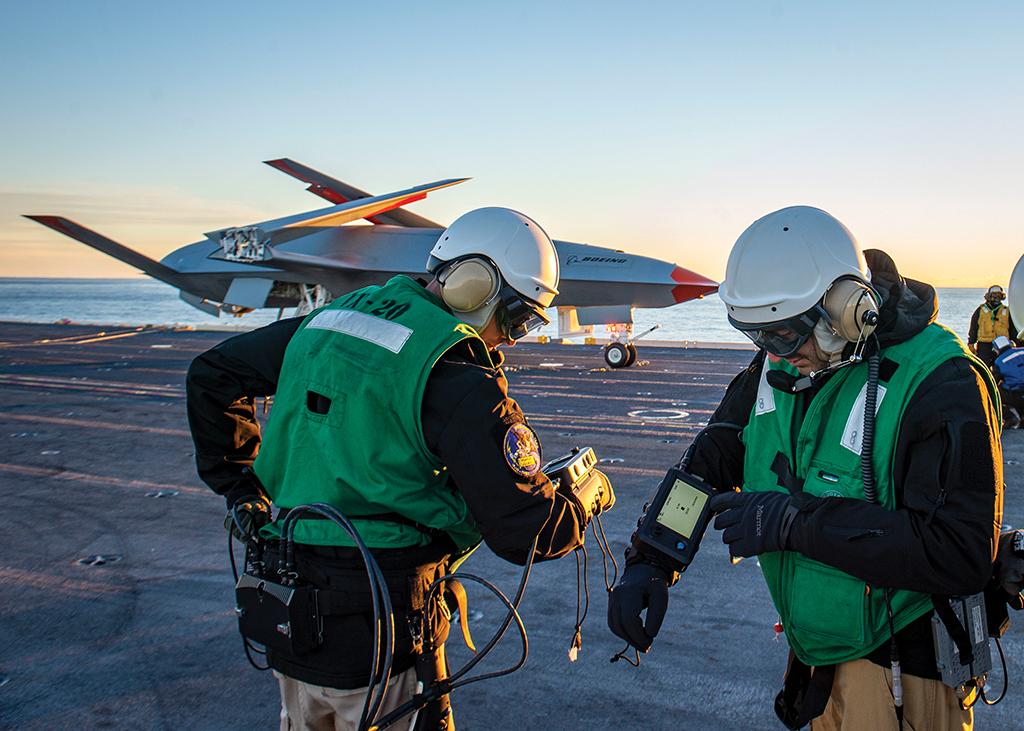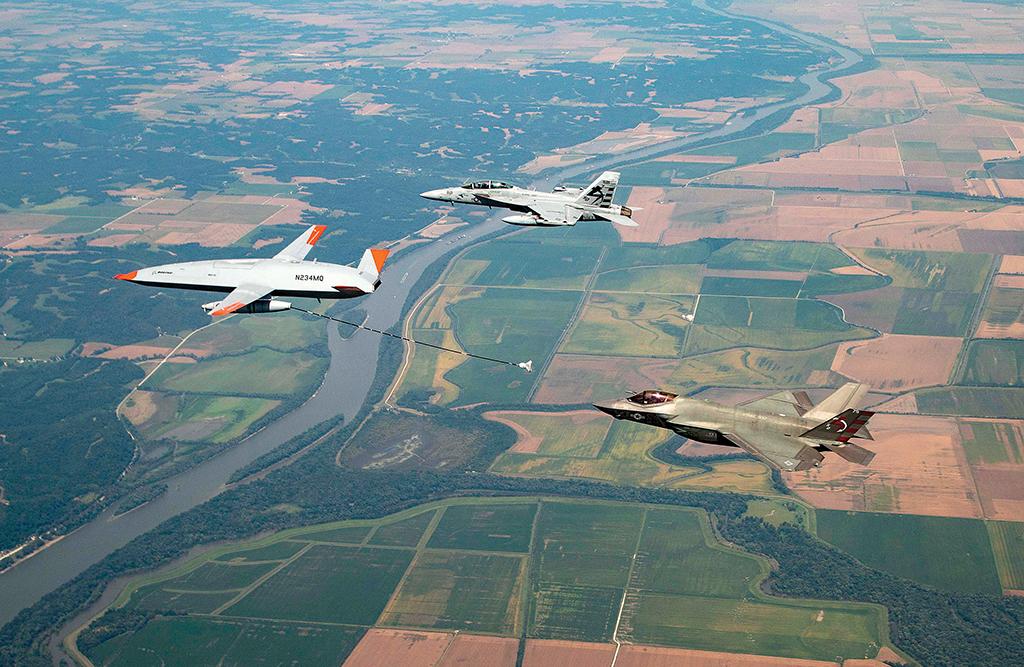
The U.S. Navy is planning for at least 60% of its carrier air wing to be uncrewed, placing faith in the development of smaller, cheaper Collaborative Combat Aircraft to do a lot of the fighting in the future alongside Lockheed Martin F-35Cs and next-generation F/A-XXs.
- Boeing’s Stingray is slated to blaze the trail
- Lockheed’s control station is being designed to fly multiple drones
- 1,300 carrier-based combat aircraft under chief of naval operation’s plan
The trailblazer for this is Boeing’s MQ-25 Stingray. In addition to passing fuel, the uncrewed refueler is testing how future collaborative combat drones will work with Navy fighters and operate on a carrier, as well as how its Lockheed Martin-built MD-5 ground control station and its sole operator will control other future uncrewed aircraft for the service.
“With these unmanned aircraft, our plan is to pair them with other unmanned systems as well as our crewed platforms,” says Cmdr. Nick Saunders, special programs branch chief in the Office of the Chief of Naval Operations. “What that’s going to allow us to do is increase the sensing and striking capability of each individual platform, and therefore the striking and sensing capability of the air wing and the strike group.”
Chief of Naval Operations Adm. Mike Gilday laid out his plan for the Navy’s future aircraft fleet in a “Navigation Plan” released in July. In it, he writes that the Navy needs approximately 1,300 long-range carrier-based combat aircraft by 2045, to include a mix of F-35s and Next-Generation Air Dominance “family of systems” aircraft—with the latter meaning both the upcoming sixth-generation F/A-XX and the Collaborative Combat Aircraft (CCA). This would be part of a total Navy fleet of 3,000 aircraft, including anti-submarine, anti-surface warfare and support aircraft.
The 60% goal, outlined by multiple officials during updates at the annual Tailhook Association symposium in September, is an increase from the previously publicly-stated goal of more than 40%. This total could mean approximately 780 of the carrier-based fleet would be uncrewed.

The Navy is starting to develop the requirements for what it would want in its Collaborative Combat Aircraft, focusing on high capability at a low enough cost to be attritable. “If it goes out and doesn’t come back, it’s not the end of the world, but I would like to get it back so I can reuse it and put it back into that space,” Saunders says.
The service wants the CCAs to be relatively small, about half the size of a Boeing F/A-18 Hornet.
Officials want potential builders to take advantage of digital engineering and full-size determinant assembly to be able to produce the aircraft quickly and cheaply. The Navy does not want a long-term, traditional acquisition but instead a “rapid generational cycle” that has not been set yet. Still, Saunders gave an example of a two-year cycle with iterative changes to provide faster updates to the fleet. Open mission systems and modular payloads are required so the aircraft can fly different missions, and the service can compete and avoid vendor lock-in for software and sensors. For some missions, the aircraft can have an infrared search-and-track (IRST) system, radar or just a radio, he says.
The Navy is planning for these systems to be able to be flown by other services or even other countries. It could take off from a carrier, show up at a location for a combat air patrol, and be taken over by the U.S. Air Force or an allied nation if needed, with efficient engines allowing them to have extended time on station, Saunders says.
The sea-based service’s plans for these systems are similar in many ways to those of the Air Force, which is planning to build large, highly capable drones to fly with its own sixth-generation Next-Generation Air Dominance platform. However, the Navy seems to be angling for a cheaper, smaller aircraft—characteristics needed for them to be able to operate at scale from carriers.
The Navy is in a “concept refinement” phase for the F/A-XX fighter, collecting input from across the service, the Air Force and intelligence agencies. It wants its F/A-XX to be a “quarterback” for the CCAs, using their endurance and lower cost to increase the range and combat capability of the future fighter, says Cmdr. Kevin Chlan, director of Next-Generation Air Dominance requirements in the Office of the Chief of Naval Operations.
While the Navy has not set the requirements for these systems, it does appear to have their entire service life planned out until the very end.
As newer and more capable aircraft come online, older ones would be removed from carrier-based service and sent to training bases such as NAS Fallon, Nevada, the site of the Fighter Weapons School, where pilots will be able to build trust in working with uncrewed systems and develop tactics as a “blue air” wingman. Eventually, they can move to fly as “red air” adversaries for Navy aircrews. Lastly, when they are old enough, they could be used as assets for further testing and development or as targets to be shot out of the sky.
All of this is years down the road, but Boeing’s MQ-25 will be the trailblazer, Navy officials say.
“MQ-25 is the guidepath. From the control station to how we employ unmanned systems around the carrier, MQ-25 is going to set the standard for us in the follow-on systems that we buy, following [the chief of naval operations’] guidepath—[which] initially started out as 40% unmanned on our way to 60% unmanned,” says Vice Adm. Kenneth Whitesell, commander of Naval Air Forces. “We’ll see how technology develops for that.”
The Navy has three MQ-25s in production and there have been 35 test flights with the Boeing-funded test assets, says Capt. Chad Fairbank, a requirements officer with the Office of the Chief of Naval Operations. The service plans initial operational capability in 2025 on the USS Theodore Roosevelt.
The service selected Lockheed Martin to develop the MD-5 ground control station with the goal of using it to control other future systems. There is very limited space aboard aircraft carriers, so multiple stations and personnel operating individual aircraft types needed to be avoided, Fairbank says.
The first role for the MQ-25 is to be a tanker, providing about 14,000 lb. of fuel at about a 500-nm range, according to the Navy. The test asset has provided fuel to a Boeing F/A-18, Northrop Grumman E-2D and Lockheed Martin F-35C in tests, along with completing a deck handling demonstration late last year.

In September, Boeing announced an all-virtual test of the MQ-25’s crewed-uncrewed teaming capabilities, with Boeing P-8s, F/A-18 Block IIIs and E-2Ds taking control of four MQ-25s to conduct surveillance missions using the company’s conceptual Project Black Ice crew vehicle interface. It was the second such demonstration, and the first time a simulated P-8 was involved. The MQ-25 used an Aurora Flight Sciences-developed autonomous framework to fly surveillance missions over the simulated ocean.
This autonomy program enabled the MQ-25 to calculate its own flightpath and do “constraint checks,” ensuring it had enough fuel to perform its mission on station and get back to the carrier on time. If these checks were all green, it would do the intelligence, surveillance and reconnaissance (ISR) mission, says BD Gaddis, Boeing’s director of MQ-25 advanced design.
The next step will be evaluating the MQ-25’s capability to serve as a communications node, using its extended range to fly into an operational area and relay communications for the entire joint force and not just the Navy.
Boeing is working to “mature” the autonomy framework used for the MQ-25, taking what other industry leaders are doing in this area to see if it can be incorporated on the Stingray. Currently, the program of record calls for the MQ-25 to be in constant contact with the carrier-based operator. That would likely not be the reality in real-world carrier operations. Communications could be degraded, or the ship could go dark and shut off its communications.
“It’s imperative we’re able to launch and recover the airplane when the carrier isn’t communicating to the unmanned airplanes,” Gaddis says. Pilots regularly train for this situation with several procedures. “How do you do that with unmanned? We have a plan, we’re working with the [Office of Naval Research] on that plan,” he adds.
Boeing’s lab is working to integrate more sensors for further ISR tests in its lab, such as an IRST. This is part of a “building block” approach to flight testing, Gaddis says, and will in turn inform the Navy’s plans for more autonomous aircraft on its carriers.
“It’s going to be the platform [we use] to figure out . . . [the] challenges [of] how to integrate unmanned systems on the carrier,” Fairbanks says. “That’s its purpose. It’s also a very, very capable [way] to extend the operational reach.”

